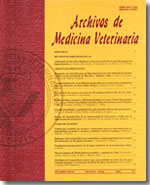Bovine embryo development produced by in vitro fertilization cultured with oviductal cell or conditioned medium and transfer to recipients
Main Article Content
Abstract
The in vitro development of matured and fertilized bovine oocytes was compared between two culture systems. Oocytes were collected by aspiration of follicles of 3-8 mm in diameter using an 18g needle. After morphological selection the oocytes were incubated at 39 0C, 5 % C02 y 95 % relative humidity, during 22 hours. Afterwards, oocytes were incubated with spermatozoa selected by Percoll gradient system. The rate of nuclear maturation and fertilization was 93,7 % (74/79) and 76,9 % (50/65), respectively. A total of 252 zygotes were cultured, 102 with oviductal cells and 150 in conditioned medium. The in vitro development on day 2 of culture (4- or 8-cell embryos) was 62,7 % (64/102) for the zygotes co-cultured with oviductal cells and 66,7 % (100/150) for the zygotes cultured in conditioned medium. The development to the morula stage was 17,6 % (18/102) for the zygotes co-cultured with oviductal cells and 13,3 % (20/150) for the zygotes cultured in conditioned medium. A statiscally significant difference was not found in the development of 4, 8-cell embryos or morula. The development of embryos up to the blastocyst stage was 15,7 % (16/102) for the zygotes co-cultured with oviductal cells. Two blastocysts were transferred to the uterine horn ipsilateral to the CL in two recipients by non-surgical embryo transfer. Pregnancy was confirmed by ultrasonography at 42 and 57 days detecting the presence of one conceptus in each animal. This work has shown that in vitro inseminated of bovine oocytes with espermatozoa prepared with modified BO and co-cultured with oviductal cells, can develop to the blastocysts stage, unlike those that were cultured with conditioned medium. Finally, it is important to mention that this is the first communication in Chile of pregnancy after in vitro fertilization of bovine oocytes.

